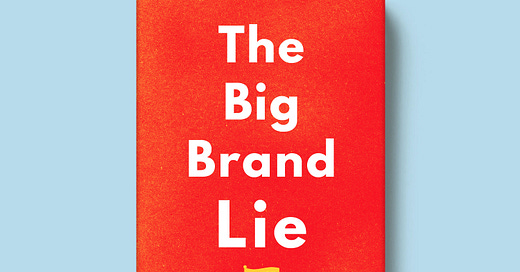The Big Brand Lie: How Categories Make Brands & Why Brand Marketers Never Believe It
Categories make brands. Not the other way around.
Arrrrr! 🏴☠️ Welcome to a 🔒 subscriber-only edition 🔒 of Category Pirates. Each week, we share radically different ideas to help you design new and different categories. For more: View the mini-book archive | Listen to a category design jam session | Dive into an audiobook | Enroll in the free Category Accelerator email course
Dear Friend, Subscriber, and Category Pirate,
Have you ever met someone who’s been drafted into a cult?
Did you know it’s possible to be in a cult and not know it?
A meaningful percentage of marketers, entrepreneurs, and executives are in what we like to call “The Brand Cult.” They’ve been taught the best (aka: “the most well known”) brand wins.
Even though the data shows this is not true.
Ford spends $2.5 billion per year on brand advertising, with a market cap of $50 billion. General Motors spends $3 billion, with a market cap of $70 billion. Meanwhile, Tesla spends $0, but has a market cap of $700 billion. What?!?
In 2011, Google spent almost $600 million building and launching a social network to compete with Facebook and Twitter called Google+. If “the best brand wins,” how come Google+ failed? After all, Forbes named Google the 2nd “most valuable brand in the world” in 2020.
Comcast spends more than $5 billion on branding and advertising each year. And yet, Comcast has long been considered “America’s Most Hated Company.” There’s even a Wikipedia page dedicated to the company’s inadequacies, titled “Criticism of Comcast.” (United Airlines is a close second, if you ask us.) So if branding and “shouting from the rooftops” is the key to winning the game, how come $5 billion per year can’t solve Comcast’s problems? Maybe they need $10 billion?
But sharing data with a cult member is about the worst thing you can do. That’s because facts are upsetting to feelings—particularly facts that disprove everything you’ve been taught to believe.
Well, here’s a fact:
Categories make brands. Not the other way around.
Want to listen to this mini-book instead? Head to the AI audiobook version, available to all paid subscribers.
How The Brand Cult Began
In 2011, The Atlantic published a piece titled, “How Brands Were Born: A Brief History of Modern Marketing.”
“In the 1950s, consumer packaged goods companies like Procter and Gamble, General Foods and Unilever developed the discipline of brand management, or marketing as we know it today, when they noticed the quality levels of products being offered by competitors around them improve. A brand manager would be responsible for giving a product an identity that distinguished it from nearly indistinguishable competitors.”
Note that last sentence.
From our perspective, the obvious response and clear “no brainer” solution to being “nearly indistinguishable” is to get different: design a new space, come up with something new, and make others play a game you created.
But that’s not what most “marketing & branding experts” decided.
Instead, they said, “Let’s ignore the fact there is nothing unique about us, our product, or what we do for the world. Instead, let’s do some branding.” As if sprinkling some kind of magic dust on your “brand” (changing the colors, the font, the logo design, etc.) is going to drive a breakthrough in growth. Or, even worse, “Let’s call ourselves a community. Let’s use big, all-encompassing, undifferentiated language to make ourselves appeal to everyone. Something like, ‘We are an authentic, purpose-driven brand.’”
And thus, “the brand cult” was formed—and The Big Brand Lie began.
“The Room Where It Happened”
We will live the rest of our lives wondering how branding as a solution to a lack of differentiation ever made it out the room (“The room where it happened”).
“No one else was in the room where it happened, the room where it happened, the room where it happened.
No one else was in the room where it happened, the room where it happened, the room where it happened.
No one knows how the game is played, the art of the trade, how the sausage gets made.
We just assumed that it happens.
But no one else is in the room where it happens.”
And yet, every single day, we are shocked by how many MBAs, entrepreneurs, founders, even very smart investors, accept this premise.
How could the answer to the problem, “We’re indistinguishable,” possibly be cosmetic attributes?
How could the answer to the problem, “We’re the same thing,” be, “Let’s say we’re the same thing, but better and louder and more often?”
How could the answer to the problem, “We’ve run out of ideas,” be, “Let’s make the logo BIGGER!?”
There are approximately 7,000 books on “branding” on Amazon.
Our guess is that many of them extol the value of “building a brand” as a path to success.
Make The Logo BIGGER!
(We encourage you to watch the above in full because we’re going to be singing the chorus all the way down the page. Arrrrrrr!)
“Make the logo BIGGER!” is the opposite of Category Design.
Category Design is the process of moving customers FROM the way the world is TO a new and different way. Categories are about customers, their problems, their opportunities, and their future—which means category marketing is about educating customers on a new and different solution that unlocks transformational outcomes by solving a specific problem.
Branding, on the other hand, is about us. Our name. Our logo. Our team. Our “mission statement.” Which means brand marketing is about screaming, “LOOK AT ME, LOOK AT ME!” Whereas category marketing is about evangelizing a different outcome altogether.
Said differently:
Brand marketing is something we do to customers.
Category marketing is something we do for customers.
The Story of Ralph Lauren
Ask any person on earth why Ralph Lauren was successful, and 99% of them will say the same thing:





